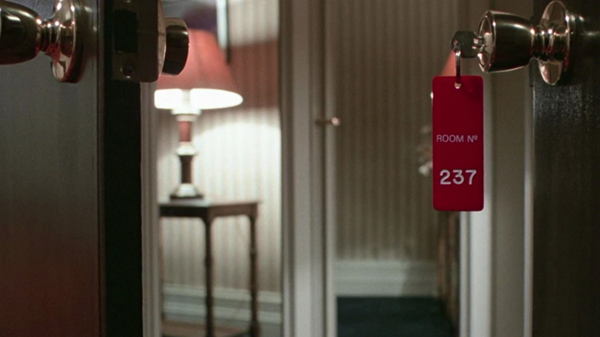“There ain’t nothing in Room 237.”
The H-Bomb: Stanley Kubrick’s The Shining is, in my always humble opinion, the greatest horror film of all time. A bold statement, I know, but I stand by it. As far as I’m concerned, it is THE horror movie. Not only is its tone undeniably creepy and its build up unbearably intense, it also creates a bizarre, surreal atmosphere that is deeply unnerving, thus making Jack Torrance’s (Jack Nicholson) descent into axe-wielding madness all the more terrifying. Often imitated but never, ever equaled, The Shining is the be all and end all of horror… I don’t give a shit if Stephen King, who wrote the novel on which the film is based, didn’t like it. His book is over-rated and his mini-series remake totally sucked ass, but I digress. Aside from being the scariest movie ever made, it is, like all of Kubrick’s films, quite the layered work, chocked full of hidden meanings, visual metaphors, a head-scratching ending, and a shitload of images and occurrences that were downright inexplicable.
This, naturally, leaves the film open to countless interpretations, and many film scholars, film buffs, psychologists, and others have studied the movie inside and out, and have offered their own unique analyses, which is all well and good. Part of The Shining’s brilliance is that it is different things to different people The ugly downside to this, is that it opens the floodgates for those with less-than-sound minds and way too much time on their hands to over-analyze the hell out of the movie and come up with crackpot theories that are howlingly pretentious at best, and astoundingly insane at worst. Which brings me to Room 237, a documentary that premiered at the 2012 Sundance Film Festival, and is, quite frankly, one of the largest cinematic repositories of bullshit that I’ve ever seen.
The film, directed and edited by Rodney Ascher, gathers five different self-proclaimed “Shining Experts,” people who have watched The Shining, forwards and backwards (literally), frame by frame (again, literally), many, many, many times over, and have developed some rather… esoteric takes on the film. A few of the theories contained with Room 237 are somewhat interesting. Most, however, are so utterly bat shit crazy that they make sense to the theorist… and the theorist alone.
It’s rather difficult to explain just how nuts most of the examinations in this “documentary” are. It’s almost the kind of thing you need to see and hear to really believe, but since I feel, at the end of the day, Room 237 isn’t really worth sitting through, I’ll try my best to explain the inexplicable. The movie opens with one of our faceless experts (none of these guys are ever actually shown, they’re only heard), reading the tagline for the European poster: “The tide of terror that swept America is here.” He then goes on to pontificate what that “tide of terror” could be referring to. It seems pretty obvious to me what it’s referring to, but I’ll indulge the guy. He asks if it’s referring to the novel it’s based on, or the movie itself (gee, ya think), or perhaps… it’s referring to the genocide carried out by the white man against the Native Americans. It was at this point, about maybe a whole minute into the documentary, that I shouted, “Oh, fuck you” at the screen. That little bit in the very beginning perfectly encapsulates the kind of off-the-wall pontificating that goes on in Room 237.
In addition to being a metaphor on Native American genocide, The Shining is also apparently a metaphor for the Holocaust, as is evidenced by the fact that Kubrick was a Jew and Jack Torrance uses a German typewriter, one that changes colors, in the film. Then there’s the job interview scene, which gets dissected to death, with such observations as the symbolic boner the Hotel Manager allegedly has when he stands up to shake Jack’s hand, the inner, deep-seated resentment carried by the Manager’s mostly silent assistant, the window inside the Manager’s office that is geographically impossible given the physical layout of the hotel, and other such incredible observations that can only be made by minds that are over-active and under-occupied. Did you know, for example, that the skiing poster in the game room has an image in the shape of a Minotaur on it? You really have to squint to see it, and in all likelihood, you won’t see it anyway, but our experts assure us it’s there. They then go on to obsess over the alleged hidden meanings in the carpet patterns, the hedge maze, the disappearing chair and the disappearing Dopey sticker, and the many other things that are too tiring to get into, but are all subject to the same outlandish dissection.
Instead of going over all of that crap, I’ll skip to the big one, the one that’s advanced late in the film, and that would make Buzz Aldrin sock the deluded blowhard espousing it right in the face; The Shining is not about a troubled family man who goes crazy in a haunted hotel. No, it’s actually Stanley Kubrick’s coded confession that not only did the U.S. fake the moon landing, but that Kubrick himself actually staged and filmed the faked moon footage that was broadcast around the world. Now, I can only imagine how folks will react to that one. Most rational folks will rightly laugh it off, whereas the Alex Jones whack-nuts of the world will embrace it like scripture. I myself was left in silent astonishment. Thus far Room 237 had presented some pretty far-fetched notions, but this one truly killed what little credibility this documentary would have had as an examination into the possible meanings underlying of one of Kubrick’s most elliptical and intriguing films.
That is why Room 237 is such a disappointment. I went in expecting a legitimate in-depth look into The Shining, but instead what I got was a laughable over-examination by a gang of disembodied crackpots whose credentials as film historians/experts are never provided by the film. Thinking about it, I have to wonder exactly what director Ascher was trying to accomplish here. Perhaps he meant it to be a case study in delusional obsession? Or maybe it’s just a joke? His way of trolling the movie buffs of the world? That really is how it comes across. But, at the end of the day, who gives an asses’ rat? Aside from the few chuckles to be had from the totally outrageous ponderings put forth, there is really nothing to be gained from seeing Room 237, certainly nothing in the way of insight into the great film it claims to examine. As The Shining’s own Dick Hallorann put it, “There ain’t nothing in Room 237. So just stay out of there. Just stay out.”




